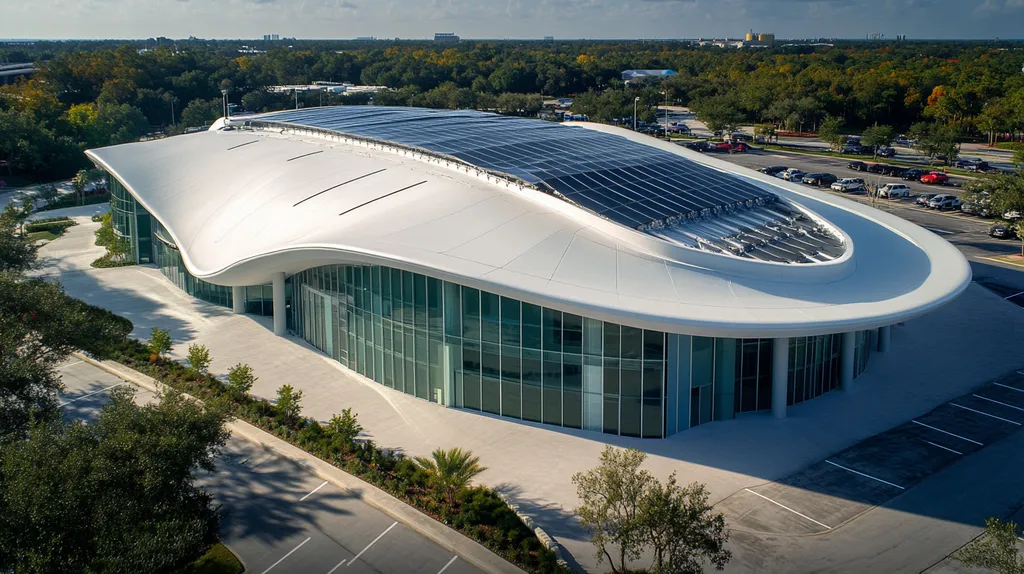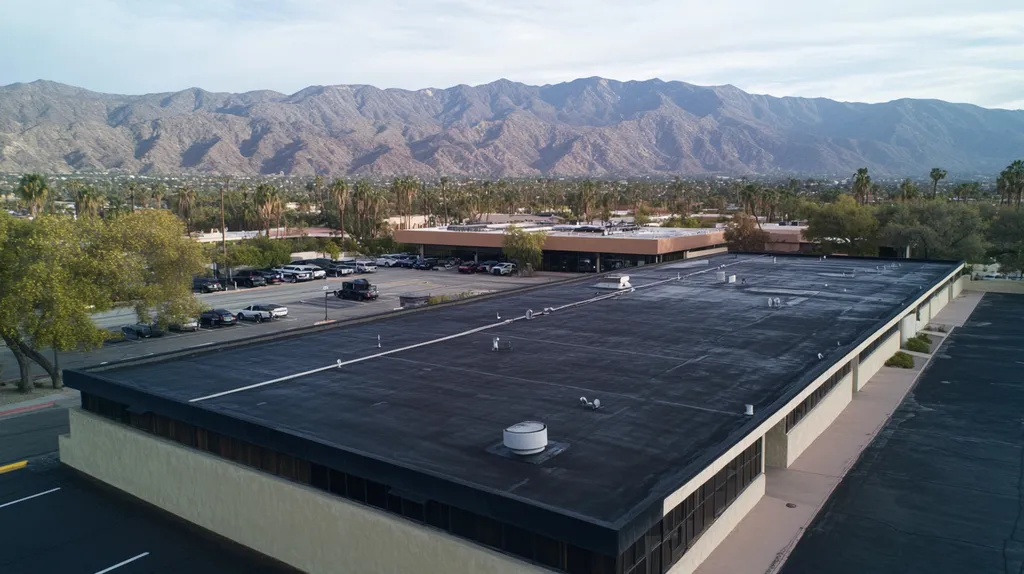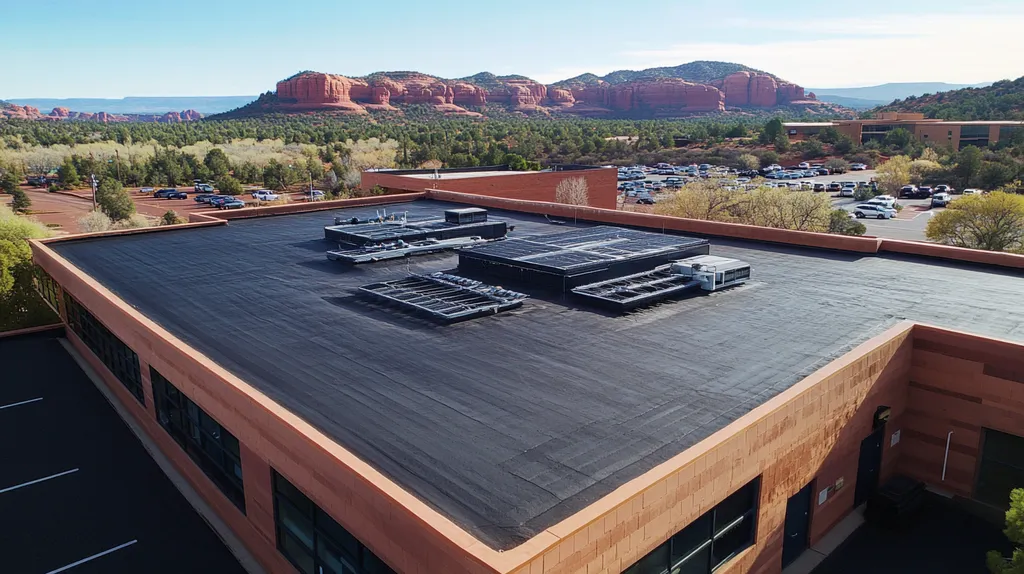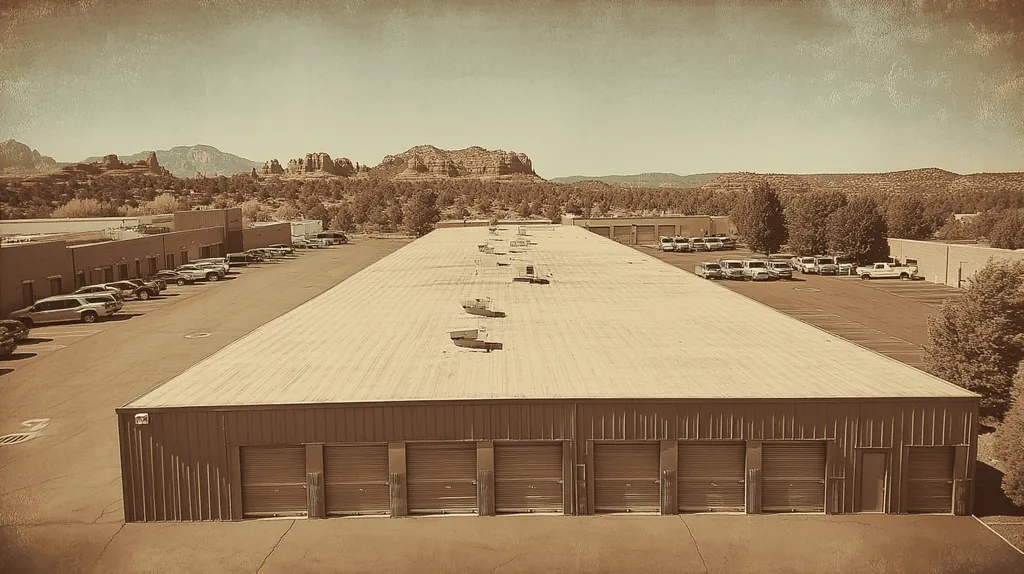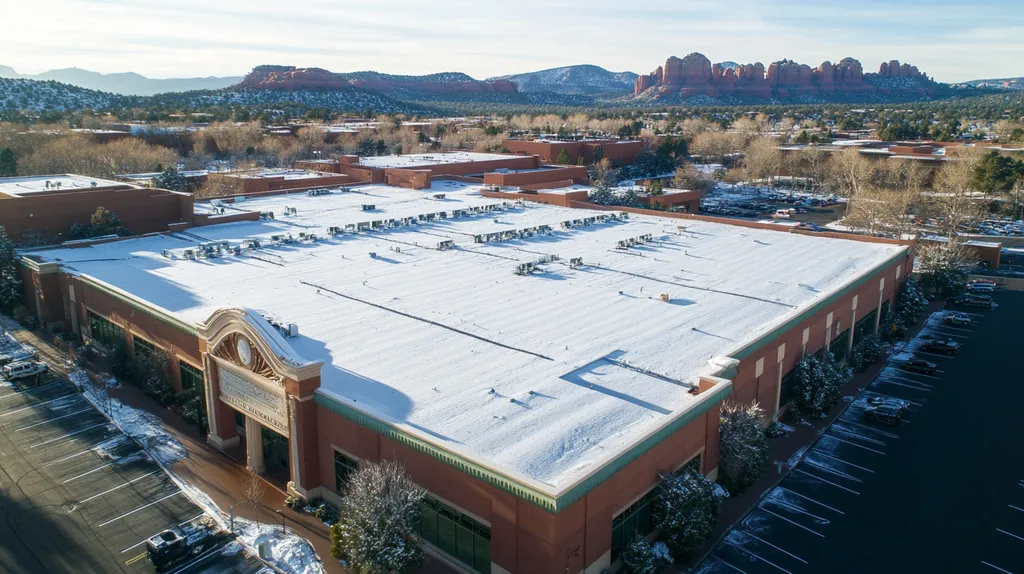In commercial roofing, inadequate ventilation can slash a roof’s lifespan by up to 50% while driving energy costs 25% higher than necessary. These sobering statistics underscore why proper ventilation has become a critical focus for property owners and facility managers.
Modern commercial buildings face unprecedented challenges in managing heat, moisture, and air quality – all of which proper ventilation directly addresses.
This comprehensive guide examines the essential components of commercial roof ventilation, from fundamental concepts to optimization strategies, providing property owners with actionable insights for maximizing their roofing investment.
SECTION 1: FUNDAMENTAL CONCEPTS
Effective roof ventilation is not merely an optional feature; it is a vital component for the longevity and efficiency of commercial roofs. Inadequate ventilation can significantly increase the risk of damage, leading to costly repairs and reduced lifespan—studies indicate that it can cut a roof’s lifespan by up to 50%. This section highlights the critical roles of ventilation in regulating temperature, managing moisture, and maintaining structural integrity.
Importance of Roof Ventilation
Roof ventilation acts as a protective barrier, facilitating air circulation to maintain a balanced environment in attic and roof spaces. Without this airflow, heat can accumulate during warmer months, causing roofing materials to wear out faster. Furthermore, stagnant air can result in condensation, which poses a threat to the longevity of building materials.
Effective ventilation also boosts energy efficiency by reducing the reliance on mechanical cooling options. For example, a properly ventilated commercial building can achieve a reduction in HVAC costs of up to 20%. This efficient airflow not only extends the life of the roof but enhances the building’s overall energy profile.
Ventilation systems, such as ridge vents and soffit vents, work together to promote fluid air movement. Unfortunately, many property owners overlook these systems, deeming them unnecessary. However, investing in top-notch ventilation can significantly reduce risks associated with temperature fluctuations.
Regular assessments of ventilation systems are crucial. Many property managers neglect this essential upkeep, which can lead to increasingly costly issues over time. Conducting routine inspections can unearth airflow blockages that compromise both ventilation efficacy and the overall investment.
Temperature Regulation and Energy Efficiency
In the summer months, the temperatures in a commercial building’s attic can skyrocket, leading to an excess of heat trapped just beneath the roof deck. This heat retention can damage roofing materials and result in higher demands on HVAC systems.
A well-ventilated roof helps moderate these temperature extremes, keeping the building cooler in summer and warmer in winter. Energy modeling has shown that proper ventilation reduces cooling costs by lowering dependence on air conditioning systems.
For instance, a manufacturing facility equipped with effective roof ventilation systems can maintain a more consistent internal temperature. This temperature stability creates a more comfortable workplace for employees and positively impacts overall productivity.
Modern energy codes frequently set specific ventilation standards to ensure energy efficiency. Companies that fail to adhere to these requirements may face penalties and higher operational costs as energy prices fluctuate.
With today’s growing environmental concerns, implementing sustainable and energy-efficient roofing solutions is paramount. Proper ventilation not only meets regulatory standards but also enhances a facility’s sustainability profile.
Moisture Management and Structural Integrity
Moisture can quietly become a significant threat to commercial roofs. Poor ventilation traps humidity, leading to condensation that can foster mold growth and decay of materials. The consequences can include weakened structural integrity and a reduced lifespan for roofing systems.
To manage moisture buildup, adequate airflow is essential. Effective ventilation helps control interior humidity levels, alleviating stress on roofing systems that could result in costly damage. Ignoring this necessity can worsen moisture-related issues and trigger a series of expensive repairs.
Furthermore, roofs lacking proper ventilation are more susceptible to ice dam formation in colder climates. When melting snow refreezes near eaves due to trapped heat, it can lead to water backups beneath roofing materials, causing leaks and further structural damage.
Grasping the dynamics of moisture is vital for facility managers focused on protecting their investments. Regular monitoring and proper ventilation can substantially reduce the risk of moisture damage, ensuring roofs remain secure for years to come.
Ultimately, prioritizing proper ventilation acts as a safeguard for achieving a balanced and healthy roofing environment. Focusing on this critical element can prevent extensive damage and lead to significant savings in both maintenance and energy costs.
SECTION 2: SYSTEM COMPONENTS
Understanding the components of roof ventilation is crucial for every property owner committed to protecting their investment. Many overlook these components, leading to severe consequences such as mold growth, structural compromise, and inflated energy bills. The National Roofing Contractors Association reports that inadequate ventilation can cut a roof’s lifespan by a staggering 25%. By familiarizing themselves with the essential parts of roof ventilation systems, property owners can ensure both the building’s health and the well-being of its occupants.
Types of Roof Vents: Active and Passive
Roof vents play a pivotal role in establishing effective ventilation, categorized mainly into two types: active and passive. Active vents utilize electrical power to enhance air circulation, making them essential in environments where humidity control is paramount. For example, powered exhaust fans actively expel stale air but come with the need for energy consumption and regular upkeep.
Conversely, passive vents operate without electrical assistance, relying solely on natural airflow. Common examples include ridge vents, gable vents, and turbine vents. These systems are appealing for many commercial properties as they provide a cost-effective way to maintain proper ventilation. The most effective approach often combines both active and passive vents to achieve optimal roof performance.
Selecting the right type of vent tailored to specific building needs is essential. Misjudging the choice could lead to inefficient ventilation or increased operational costs. Ultimately, the decision between active and passive vents greatly influences the health and longevity of the roofing system.
Intake and Exhaust Vent Systems
Ventilation systems typically encompass two main components: intake and exhaust systems. Intake vents are designed to bring in fresh air, while exhaust vents play a crucial role in removing warm, stale air from the roof space. Achieving the right balance between these two is vital for effective roof ventilation.
For instance, ridge vents serve as exhaust points at the roof’s peak, allowing hot air to escape, while soffit vents function as intake points located along the eaves. This harmonious combination fosters consistent airflow, regulating both temperature and moisture levels within the roof structure.
Conversely, a poorly designed intake and exhaust system can create pressure imbalances, leading to decreased ventilation effectiveness. Owners must prioritize achieving the correct ratios between intake and exhaust to ensure long-term durability and integrity of the roof. Understanding this balance is essential to avoiding costly repairs down the line.
Ventilation Materials and Standards
The materials chosen for roof ventilation systems significantly impact their performance and longevity. It is crucial to select high-quality materials—such as stainless steel and robust plastics—that can withstand environmental stressors. Using inferior materials may lead to premature failures and escalated maintenance expenses.
Moreover, adhering to established industry standards, such as those set by the American Society for Testing and Materials (ASTM), is essential for compliance and performance assurance. These guidelines provide recommendations on material selection and best practices for installation.
Ignoring compliance with established standards may expose property owners to serious risks, including higher energy costs and health issues arising from mold proliferation. Staying informed about the best practices in material selection not only optimizes roof ventilation performance but also safeguards compliance with regulatory requirements.
SECTION 3: IMPLEMENTATION METHODS
Implementing effective ventilation in commercial roofing is not just a good idea—it’s essential for building protection and energy efficiency. Without proper ventilation, businesses may face skyrocketing energy bills, structural damage, and a drop in comfort for occupants. Alarmingly, up to 30% of the energy costs in commercial buildings can be directly linked to inadequate ventilation practices. Understanding how to evaluate, install, and integrate ventilation systems is crucial for property owners and facility managers committed to ensuring their buildings operate efficiently.
Assessing Ventilation Needs for Commercial Buildings
Evaluating ventilation requirements begins with a comprehensive look at the building itself. Property owners must take into account the architecture, insulation materials, and current airflow patterns. Professional assessments often employ techniques like smoke tests or anemometers, tools that help pinpoint airflow dynamics and potential problem areas.
Additionally, the building’s function plays a critical role. For instance, a manufacturing facility may require different ventilation solutions than a standard office building. Adhering to local building codes is equally important, as these regulations frequently outline specific ventilation standards that must be met.
A data-driven approach can help determine the ideal airflow necessary for optimal performance. A practical guideline is to aim for air exchanges every 30 minutes to maintain efficiency. Conducting regular assessments can adapt ventilation strategies to changes in building usage or occupancy, ultimately saving money and extending the roof’s lifespan.
Installing Intake and Exhaust Vents
After assessing ventilation needs, installing the right intake and exhaust vents is the next critical step. Intake vents bring in fresh air, while exhaust vents expel warm, stale air. This balance in airflow is essential for avoiding moisture accumulation, which can lead to serious structural issues.
Location is paramount during installation. Intake vents should be positioned low to the ground and away from potential obstructions, while exhaust vents need to be higher up to effectively facilitate air removal. A recommended intake-to-exhaust vent ratio is around 1:300 to ensure proper airflow levels.
Installation techniques may vary based on roof type, as low-slope roofs often require different strategies than their steep-slope counterparts. Sealing and insulating around the vents is crucial to prevent leaks and enhance the effectiveness of the ventilation system.
Regular inspections are essential to keep vents free from debris or snow. Proper maintenance is key to ensuring that these systems perform efficiently over time.
Integrating Ventilation with Insulation
For maximum energy efficiency, it’s vital that ventilation and insulation work seamlessly together. Proper insulation reduces heat loss in winter and minimizes heat gain during summer, complementing the functions of ventilation systems.
When integrating these two systems, selecting insulation materials with appropriate R-values based on the building’s climate zone is crucial. It’s also important to install insulation without obstructing airflow from vents, as blocked airflow can trap heat and increase humidity levels.
A well-insulated roof will lighten the load on heating and cooling systems, leading to lower energy consumption. For example, using spray foam insulation can create a continuous barrier that enhances both insulation and ventilation effectiveness.
Collaboration between roofing contractors and insulation professionals is essential for devising a coordinated approach. This partnership ensures that both ventilation and insulation function in harmony, safeguarding both the building’s structural integrity and occupant comfort.
SECTION 4: MAINTENANCE REQUIREMENTS
Ensuring proper ventilation in commercial roofs is essential for maximizing performance and efficiency. Neglecting routine maintenance can lead to costly damage, with studies indicating that inadequate ventilation can cut a roof’s lifespan by up to 30% and raise energy expenses by 20%. By adopting a proactive maintenance strategy, building owners can identify potential issues before they evolve into costly problems.
Regular Inspections and Maintenance Schedules
Implementing a regular inspection schedule is critical to maintaining effective roof ventilation. Property owners should aim to conduct evaluations at least twice a year, ideally in the spring and fall. These inspections allow technicians to check for general wear and tear on ventilation systems.
Routine assessments also provide opportunities to evaluate airflow and temperature regulation. Any unusual readings can signal ventilation issues that warrant immediate attention. Addressing discrepancies early on can prevent significant repairs in the future.
Keeping detailed records of each inspection is paramount. Documenting findings and subsequent actions provides invaluable insights into the roof’s health over time. This organized approach helps maintain compliance with regulations and aids in making informed future maintenance decisions.
Additionally, monitoring energy efficiency is essential. Sudden increases in energy bills can be a red flag indicating that ventilation systems are failing. By proactively addressing these signs, property owners can save on energy costs and prolong the lifespan of their roofs.
Identifying and Fixing Ventilation Issues
Spotting ventilation problems early can prevent significant financial losses for building owners. Indicators such as excessive mold growth, warping roofing materials, and fluctuating indoor temperatures often point to ventilation deficiencies.
Proper training for maintenance staff is crucial for identifying these signs. Their ability to assess airflow and pinpoint relevant areas of concern can lead to timely intervention. When issues are spotted, swift action is necessary to minimize further damage.
In some cases, installing additional vents or upgrading existing systems may be required. For instance, adding turbine vents enhances airflow and improves heat and moisture regulation. This proactive stance helps ensure overall roof efficiency.
Ultimately, maintaining optimal ventilation hinges on continuous evaluation and timely adjustments. Prioritizing these actions is critical for preserving the roof’s functionality and avoiding costly repair scenarios down the line.
Preventing Blockages and Damage
Blockages can drastically hinder a roof’s ventilation, resulting in a multitude of issues. Debris, such as leaves, dirt, and snow, can obstruct airflow and create hotspots. Therefore, property owners should regularly clear vents and exhaust systems to maintain optimal performance.
Implementing seasonal cleanings proves effective in preventing blockages. Utilizing professional cleaning services helps ensure thorough cleaning, especially in challenging areas like roof slopes and gutters. Keeping these areas clear reduces the risk of moisture buildup and subsequent structural damage.
Another effective preventive measure is the installation of screens or filters in ventilation systems. While they can catch debris, it’s essential to inspect and clean these regularly to prevent them from causing additional blockages.
Ultimately, taking proactive steps to prevent blockages and damage is vital for maintaining roof ventilation. It is far more economical to thwart these issues rather than address them after they have escalated into significant repair needs. Ensuring clear internal ventilation pathways not only boosts energy efficiency but also extends the life of the roof.
SECTION 5: PERFORMANCE METRICS
Understanding the performance metrics associated with ventilation is essential for commercial roofs. Without adequate ventilation, roofs face increased heat buildup, resulting in soaring energy costs. Studies show that buildings lacking proper ventilation can incur energy expenses that are 25% higher than those with effective systems. This section delves into key performance metrics, including energy savings, indoor air quality, and roof lifespan, highlighting their significance for effective ventilation management.
Energy Savings and Cost Analysis
Efficient roof ventilation is directly linked to reduced energy spending. A well-ventilated roof enhances airflow, lowering air conditioning demands during the hot summer months. This improvement not only boosts energy efficiency but also translates into substantial cost savings over time.
For example, studies suggest that a properly installed ventilation system can reduce cooling costs by 10-20%. This potential for savings is often overlooked by property managers, who might miss opportunities to reinvest those funds into vital building upgrades.
Moreover, energy-efficient roofing systems may qualify for utility rebates. These incentives reward property owners for investing in energy-saving solutions, ultimately making initial installation more affordable.
By monitoring energy consumption metrics, property owners can evaluate the financial implications of their ventilation systems in real time. An effective energy management strategy plays a critical role in budgeting and long-term financial planning.
Indoor Air Quality and Comfort Metrics
Indoor air quality (IAQ) is vital for the health and productivity of building occupants. Poor ventilation can lead to an accumulation of moisture, pollutants, and harmful particulates, negatively impacting both comfort and employee well-being.
Research indicates that enhancing IAQ can boost employee performance by up to 10%. Therefore, investing in a well-ventilated roofing system yields substantial benefits in terms of comfort and productivity.
Regularly monitoring IAQ metrics should be integral to a facility manager’s strategy. Utilizing sensors and conducting air quality assessments can provide valuable insights into how effectively the ventilation systems are performing.
Ultimately, a dedication to maintaining superior IAQ through thoughtful roof ventilation can result in lower absenteeism rates and elevated employee morale, underscoring the importance of this often-overlooked aspect of effective roof management.
Roof Lifespan and Durability Indicators
Proper ventilation is crucial for extending the lifespan of commercial roofs. Inadequate ventilation can lead to moisture accumulation, fostering issues like mold growth and significantly reducing the roof’s lifespan.
Studies indicate that roofs with adequate ventilation can last 20-30% longer than those lacking sufficient airflow. This longevity translates into lower replacement costs and less frequent repairs, making for a more sustainable roofing solution.
Regular inspections and metrics that assess roof conditions can highlight the vital relationship between ventilation and durability. Techniques such as moisture and thermal imaging tests can paint a comprehensive picture of how effectively ventilation supports roof longevity.
By understanding and diligently monitoring these critical performance metrics, property managers can make informed decisions that foster long-lasting, efficient, and comfortable building environments.
SECTION 5: PERFORMANCE METRICS
Recognizing ventilation performance metrics is essential for the management of commercial roofs. Inadequate ventilation leads to heat accumulation, resulting in significantly higher energy costs for property owners. Research shows that buildings lacking sufficient ventilation can incur energy expenses that are 25% greater than those with effective systems in place. This section will delve into critical performance metrics, such as energy savings, indoor air quality, and roof lifespan, emphasizing their significance for successful ventilation management.
Energy Savings and Cost Analysis
Optimizing roof ventilation directly correlates with decreased energy expenditures. A well-ventilated roof enhances airflow, enabling air conditioning systems to operate more efficiently during hot seasons. This improvement not only boosts energy efficiency but also results in considerable cost savings over time.
For example, studies indicate that a properly installed ventilation system can reduce cooling costs by 10-20%, often overlooked by property managers who might miss these savings opportunities. Funds saved can be reinvested into vital improvements for the building.
Moreover, energy-efficient roofing systems can qualify for utility rebates. These financial incentives reward property owners for adopting energy-saving solutions, ultimately lowering installation costs.
By tracking energy consumption metrics, property owners can gain real-time insights into the financial implications of their ventilation systems. An effective energy management strategy is vital for sound budgeting and long-term financial planning.
Indoor Air Quality and Comfort Metrics
Indoor air quality (IAQ) is crucial for the health and productivity of building occupants. Poor ventilation often leads to the buildup of moisture, pollutants, and harmful particulates, which can adversely affect comfort and employee well-being.
Research has shown that improved IAQ can enhance worker performance by up to 10%. Therefore, investing in an effective roof ventilation system not only elevates comfort but also significantly boosts productivity.
Regular monitoring of IAQ metrics should be a fundamental aspect of any facility manager’s approach. Utilizing sensors and conducting air quality assessments can yield valuable insights into the effectiveness of the building’s ventilation efforts.
Ultimately, maintaining superior IAQ through proper ventilation fosters lower absenteeism rates and higher employee morale, highlighting the importance of this often-overlooked facet of effective roof management.
Roof Lifespan and Durability Indicators
Proper ventilation is pivotal for prolonging the lifespan of commercial roofs. Insufficient ventilation allows for moisture accumulation, leading to serious damage, including mold growth, which drastically shortens the roof’s life.
Evidence suggests that roofs equipped with adequate ventilation can last 20-30% longer than those without it. This longevity translates into lower replacement costs and less frequent repairs, making for a more sustainable roofing solution.
Regular inspections and condition metrics can illustrate the relationship between ventilation and durability. Techniques such as moisture and thermal imaging tests can provide a comprehensive understanding of how well ventilation supports roof longevity.
By diligently monitoring these key performance metrics, property managers can make informed decisions that promote a long-lasting, efficient, and comfortable building environment.
Moving Forward
With up to 50% shorter roof lifespans and 25% higher energy costs at stake, proper commercial roof ventilation can no longer be treated as optional.
The integration of modern ventilation technologies, combined with regular maintenance and performance monitoring, represents a critical investment in building infrastructure.
Property owners who implement comprehensive ventilation strategies – from proper system design to ongoing optimization – position themselves to capture significant cost savings while ensuring optimal building performance.
As climate challenges and energy costs continue to rise, effective roof ventilation will become increasingly vital for commercial property sustainability and value preservation.
The time to act is now – before inadequate ventilation leads to costly structural damage, compromised indoor air quality, and escalating operational expenses.
FREQUENTLY ASKED QUESTIONS
Q. Why is ventilation important for a commercial roof?
A. Effective ventilation in a commercial roof regulates temperature and manages moisture. This airflow prevents damage from heat and condensation, ultimately enhancing the roof’s lifespan and energy efficiency by reducing reliance on HVAC systems.
Q. What components are needed for proper ventilation in an industrial roof?
A. Essential components include active and passive vents, which help facilitate airflow. Intake vents draw in fresh air while exhaust vents remove heated air, creating a balanced system crucial for maintaining structural integrity and comfort.
Q. How can I assess ventilation needs for my commercial roof?
A. Begin by evaluating the building’s architecture and current airflow patterns. Conducting smoke tests or using anemometers can help identify areas requiring additional ventilation to optimize air purity and thermal control.
Q. What maintenance is required for commercial roof ventilation systems?
A. Regular inspections at least twice a year are crucial for optimal maintenance. Checking for blockages, wear and tear, and effectiveness of airflow ensures timely interventions and can extend the roof’s lifespan significantly.
Q. What performance metrics should I monitor for my commercial roof’s ventilation?
A. Key metrics include energy savings, indoor air quality, and the roof’s lifespan. Tracking these indicators allows property managers to evaluate ventilation effectiveness and make informed decisions about maintenance and improvements.
Q. How does ventilation impact indoor air quality in a commercial building?
A. Proper ventilation improves indoor air quality by reducing moisture, pollutants, and harmful particulates. This not only enhances comfort but can also significantly increase employee productivity and overall well-being within the workspace.
Q. How can I integrate insulation and ventilation systems effectively?
A. To integrate these systems, select insulation materials that do not obstruct airflow. Proper installation ensures that both systems function together, maximizing energy efficiency and maintaining comfortable indoor temperatures throughout the year.


